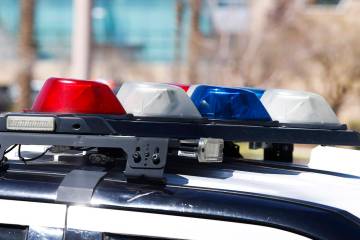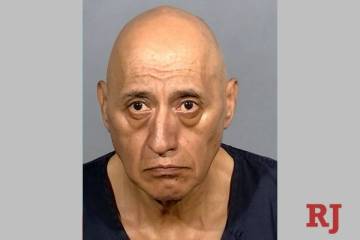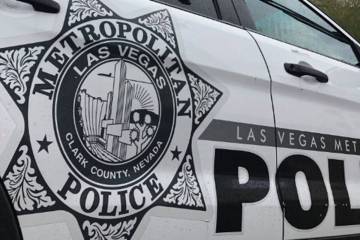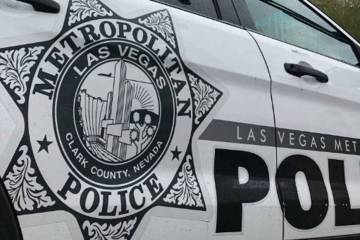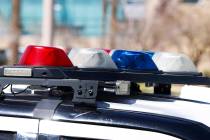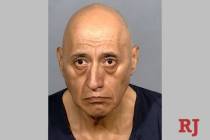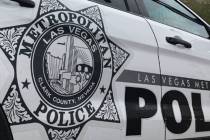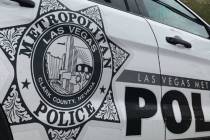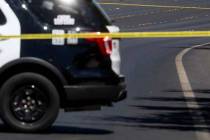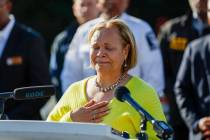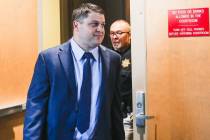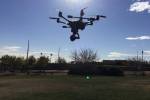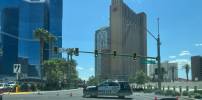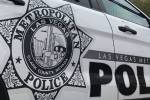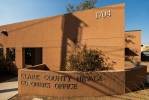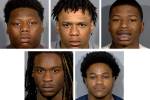Officers’ reports illustrate chaos, confusion of Las Vegas shooting
It was the kind of overtime assignment cops dream about.
On Oct. 1, Metropolitan Police Department officer Mark Bordoni was looking forward to a pleasant night outside, surrounded by friendly country music fans more interested in shaking his hand and posing for pictures with him than starting trouble.
He and his partner even bumped into an old friend and co-worker, a smiling officer Charleston “Charlie” Hartfield, who was there with his wife to enjoy the music on his night off.
But when the shooting started a few hours later, Bordoni found himself in the same position as the people he was there to protect: confused, unclear where all the gunfire was coming from, and uncertain if he would make it out alive.
“I remember very clearly thinking, ‘This is it. I only have my Glock 9mm, and I’m probably up against a fully stocked assault team with tactical gear,” Bordoni wrote in his report from that night. “I would have bet my paycheck there was an assault team on the ground, in full tack gear and … going to overrun us at any moment.”
Bordoni’s account was one of more than 500 reports from officers released by Metro under court order Wednesday, providing the most detailed and wide-ranging picture yet of the massive law enforcement response to the Strip-wide chaos and confusion of Oct. 1.

Swarming the Strip
As the barrage of bullets kept coming at concertgoers — and even after the shooting stopped — officers from all over the valley swarmed the Strip in perhaps the largest police response in Las Vegas history.
At least 50 officers were already at the event, working overtime like Bordoni, and without warning found themselves at ground zero.
Many others working in different patrol areas across the county quickly abandoned their posts and sped to the scene, running lights and sirens down surface streets as the situation grew more and more dire over their radios.
Some officers were on jogs in their neighborhoods or at home in their beds when they answered calls and texts on their personal cellphones from relatives watching the news or friends at the festival venue, frantic for information.
Without direction from supervisors, they tuned into scanner traffic, suited up, hopped in their cars and rushed to help.
Once on scene, some directed traffic or joined show-of-force patrols on the Strip meant to restore calm. Others formed strike teams to investigate false reports of active shooters inside the Aria, Bellagio, Caesars Palace, Circus Circus, New York-New York, Paris Las Vegas and Tropicana.
One officer spent part of his shift clearing tourists from the pedestrian bridges along Las Vegas Boulevard and ended his day at the festival grounds, placing bodies in black bags supplied by the coroner’s office.
False reports
In some cases, the response by authorities triggered more reports of possible shooters.
At Caesars, a report of an armed man turned out to be a plainclothes security executive carrying a rifle. At the Bellagio, police went looking for a man seen jumping out of a white Ford Dually F-350 with a rifle and tactical vest, only to discover he was a vice president of security.
As one Metro officer put it in his report: “At this time we began to realize the new calls of shooters were either diversions to get police to spread out or it was citizens calling in plain clothed officers.”
But at least some of the false alarms came from — or were echoed over the air by — police in the field.
The chaos eventually was addressed by a radio dispatcher: “Everybody take a deep breath and slow down. Please attempt to verify information before you broadcast it,” the dispatcher said, according to an officer report.
Meanwhile, at Mandalay Bay, a responding officer found the lobby strangely relaxed.
“I saw that no one had any idea of what was happening outside,” the officer wrote. “No one ran or hid. It was eerie calm, business as usual as if nothing had happened.”
Fight for records
The document dump Wednesday totaled about 2,000 pages. Mixed in with the reports from officers were witness statements and dispatch logs from the tragedy, which left 58 dead and hundreds more injured.
The Las Vegas Review-Journal and other media organizations sued for their release when Metro refused to hand the public records over in the days after the mass shooting.
Last week, Metro released 1,200 pages of witness statements. Earlier this month, the department released body camera footage from two different officers who helped breach the gunman’s room. More records are expected over the next several months.
One word appears over and over again in records released Wednesday — fireworks.
Concertgoers, festival employees, performers and even police officers at the scene said they mistook the initial shots as some strangely timed pyrotechnic display.
Officers offered stark accounts of what they saw at the festival grounds.
“What laid before us was an open, dark field scattered with the injured, deceased, and those remaining to render aid,” one officer wrote.
Another wrote: “I looked around and saw some people trying to cover the bodies with banners they must have torn down from fences and stage area.”
One off-duty officer who attended the concert with her 13-year-old daughter described holding the girl’s hand as she made her way through the venue, helping tie tourniquets, bandage wounds and load victims into vehicles headed to the hospital. Once outside and back at their vehicle, the woman told her daughter to “lie down on the floor in the back seat, and call Grandma.”
Eyes in sky
Shortly after the shooting began, Lt. Kenny Delzer received a call from his wife, a Paris Las Vegas employee. She wanted to know why there were so many police cars traveling “southbound on the Strip with their lights and sirens on.”
Delzer, part of the department’s Emergency Operations Bureau, turned on his radio and heard reports of gunfire. He began to organize helicopter operations.
When he reached the temporary aircraft staging area at the Las Vegas Harley-Davidson dealership, he loaded two SWAT snipers in the back of a helicopter and sent them up to “stop the threat and to address additional threats if needed,” Delzer wrote.
He also called in a second helicopter “in anticipation of a secondary attack.” The two aircraft continued to patrol for out-of-place vehicles and suspicious activity on hotel rooftops until the flight operation was shut down at 3:30 a.m.
At least one terrified concertgoer didn’t realize the air units were there to help her.
“It was total confusion,” wrote the woman, whose name was redacted from the witness statement she gave to police. “At this point I thought the shots were coming from a helicopter not the Mandalay Bay. A helicopter (which turned out to be a Metro chopper) flew over and I panicked thinking we were going to get shot at.”
Finding the fallen
At Sunrise Hospital and Medical Center, nurses and doctors were dealing with a sudden surge of trauma patients.
“The staff at Sunrise was unbelievably proficient and professional and deserve major credit on handling such a dynamic situation,” one officer wrote. “Their calmness was key to handling the influx of patients.”
As officers arrived to help, they worked with “little to no instructions” from police supervisors, an officer wrote. Without direction, they began interviewing the injured.
Soon, a new task developed: identifying the dead. Many did not have wallets or cards on them, so officers jotted down their physical descriptions and collected items that were left in pockets or in purses.
Because the hospital was overwhelmed, the dead were held in different places, an officer noted. One group of bodies was placed in the same hospital room; another group was placed in the lower level of the hospital’s parking garage.
A few hours after the shooting, police at Sunrise received word that Hartfield may have died, and that his body may be at the hospital. They knew this because Hartfield’s wife was at University Medical Center, trying to find him.
Two officers who worked with Hartfield began checking bodies in hopes of finding the 34-year-old Army veteran.
When they believed they found him, they used his tattoos to confirm his identity. Then they had other officers notify his wife.
Until his body was removed from the hospital, Metro’s honor guard stood watch outside the room.

Far-flung response
The police response the night of the shooting reached as far as Overton, where the sole Metro officer working patrol duty in the town about 60 miles northeast of Las Vegas was sent to gunman Stephen Paddock’s home in Mesquite.
When officer Nathan Bradford arrived at the house at about 1:20 a.m., he worked as a liaison between Metro and Mesquite police. He also ensured no people or cars made their way down the gunman’s residential street, because police “did not know what dangers may have been in Paddock’s house.”
Later, Bradford kept watch as detectives and SWAT officers served a search warrant on the home. His shift finally ended at 6:12 a.m., about five hours later than usual.
“Due to the nature of the call and our purpose in being there, I never considered the time,” Bradford wrote. “I feel that my role in the whole event is insignificant as I learned of all the devastation that occurred at the actual scene, especially as I found out about the casualties, the injured and especially knowing some of my very close friends were officers at the scene.”
Contact Rachel Crosby at rcrosby@reviewjournal.com or 702-477-8301. Follow @rachelacrosby on Twitter. Contact Henry Brean at hbrean@reviewjournal.com or 702-383-0350. Follow @RefriedBrean on Twitter. Contact Madelyn Reese at mreese@viewnews.com. Follow @MadelynGReese on Twitter. Review-Journal staff writers Jamie Munks, Michael Scott Davidson, Wade Millward, Mike Shoro and Blake Apgar contributed to this report.
Related
Reports describe Las Vegas gunman's rental of downtown condos
Jason Aldean's statement shows actions at Las Vegas shooting
Las Vegas officer recalls efforts to reach shooter's hotel floor
Accounts of workers among newly released Las Vegas shooting records
Report says California officer was injured during Las Vegas shooting




